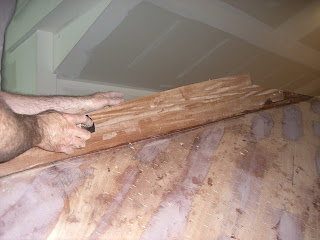Saturday, January 17, 2015
The 1500 Hour Mark
The outer stem that had been previously bent to shape was readied for application.

The ends of the strip planking are visible at the bow, under the veneer layers, prior to the outer stem being epoxied in place.

There was quite a bit of head scratching while trying to figure out how the outer stem should be shaped and how the fairing of the stem would ultimately flow into the keel. We searched on-line for pictures of the bows from traditional boats. Unfortunately, there are very few frontal pics of the bow up near the sprit, since a boat generally needs to be on-the-hard to get that view. We even took a "field trip" down to local sailboat yard. Of course, most modern glass boats dont even have an obvious outer stem, but we did get a few ideas.
We decided that a large chamfer on each side should roll into a traditional cove shape at the top, giving some meat to the squared off area under the future bow sprit. As Richard started the shaping, he realized that the chamfer was actually a continuation of the faired hull, thus as he brought the line of the hull forward, the leading edge of the outer stem worked out to be exactly as wide as specd in the plans. All that head scratching for nothing! The coves were shaped free hand and the proportions turned out very sweet in my opinion.

The fairing continued......this time, this final fairing must be as perfect as possible, to prevent dips and ridges in the final smooth "glass" finish of the hull. Finally he is getting down to the very visual aspects of construction.

The long board with 40 grit paper is known as the "torture board" for good reason.

It is a flexible board that is swept across the hull in long arcs, with enough of pressure applied to actually "cut" into any high spots.

To ensure a very smooth glass surface, the entire hull was lovingly stroked with wide arm movements and marked so that every dip and high spot could be removed with filling and/or sanding. This was humorous to watch, as Richard and his friends would close their eyes to better "visualize" the surface.

The meticulous fairing of the project at each stage of construction, from the frames and strip planking to veneering really paid off. The hull is very smooth and appears to be right on the offsets provided in the plans.

Then one sunny day....we decided to see if she would actually make it out of the "boat barn". This aspect of the build had always been rather theoretical. The hull was rigid enough at this point that Richard had placed large casters under the previously floor-mounted strong back. There was no risk of torquing the hull out of shape now, so we figured we would give it a try. We both had secretly worried that there would be some wall removal involved in her extrication.

We moved the stern far to her starboard side....

That lined her up to be pushed forward into the garage area.

Looking pretty tight....

She made it into the garage....

And her nose had to tuck up very tight against the cabinets in the corner.

Looking good...here comes the critical part...

Now her stern must clear the exterior wall on the right....

Looking good...

Yahoo! The wall does not need to be removed...


The whale tail appearance of the transom will be gone with the addition of the bulwarks, and the taffrail which is the rail around the stern.



Once the laminating was done, the deadwood needed to be planed done to the right width with a hand and power plane.
Richard marked the width of the keel and the rabbets from the offsets and then worked them in to the flow.




A little radius is put on the edges.

But to me, the height looks pretty questionable.....especially since the deadwood (keel) needs to be applied prior to removal. Richard measured the height using a level, etc and assures me there is an inch and a half to spare....of course we always have the option of lowering the cradle...

The whale tail appearance of the transom will be gone with the addition of the bulwarks, and the taffrail which is the rail around the stern.
Richard then started to lay up and shape the forward deadwood. The deadwood is the wood buildup area in front and behind the lead ballast, shaped to create the keel and to hold the lead ballast in place.

The joint where the outer stem meets the deadwood has potential for needing to handle a jarring with any kind of grounding.

The back end of the forward deadwood is shaped to receive the lead ballast.

Once the laminating was done, the deadwood needed to be planed done to the right width with a hand and power plane.

Richard marked the width of the keel and the rabbets from the offsets and then worked them in to the flow.

Work it...check it...rework it...

A little here, a little there....

Then to the other side to even it up.

A sharp hand plane is indispensable.

A little radius is put on the edges.

I think a little more work is needed to remove the lump where the outer stem turns into the deadwood.
The 1500 build hour mark has been reached. Richard has kept close records on his WoodenBoat calendar, with what has been accomplished each day.
Subscribe to:
Post Comments (Atom)
No comments:
Post a Comment